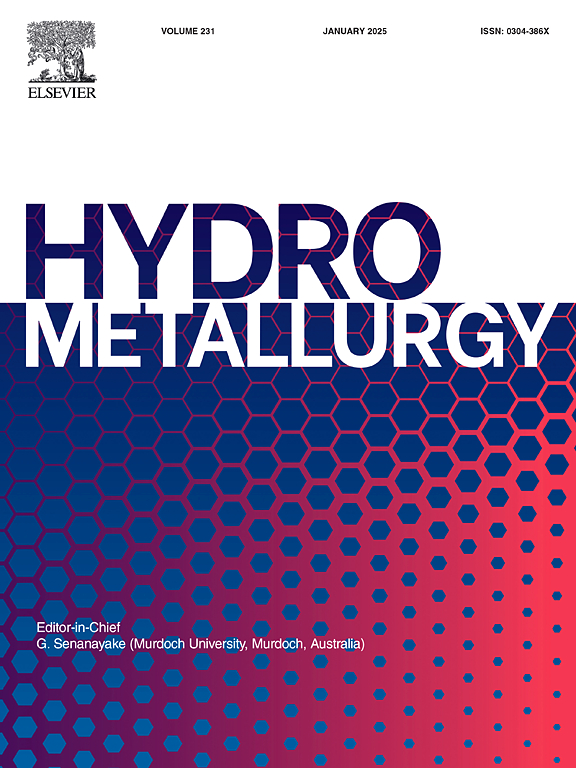Leaching kinetics of molybdenite with layered structure and hydrophobic properties in the H2SO4-H2O2-H2O system at atmospheric pressure
IF 4.8
2区 材料科学
Q1 METALLURGY & METALLURGICAL ENGINEERING
引用次数: 0
Abstract
Previous studies on the leaching kinetics of molybdenite were primarily based on processing data using a contraction core model with spherical mineral particles. However, molybdenite particles exhibit a thin plate and layered structure. In this study, a model of circular particles was employed to derive the kinetic equation. The apparent activation energies of the molybdenite leaching reaction, both without mechanical activation and with mechanical activation treatment, were calculated as 55.3 kJ/mol and 49.5 kJ/mol, respectively. The layered structure of molybdenite renders its mineral particles challenging to grind during the ball milling process. Nonetheless, this process enhanced the active point of the mineral to a certain extent, thereby facilitating the leaching reaction. The rate-limiting step of the leaching reaction was identified as the chemical reaction step. Specifically, the reaction order of H2SO4 and H2O2 were determined as 0.063 and 0.959, respectively. Notably, variations in the H2O2 concentration exerted a significant impact on the leaching effect, while changes in the concentration of H2SO4 exhibited a relatively smaller effect. Additionally, molybdenite exhibited strong hydrophobic properties. The addition of surfactants improved the reaction environment and enhanced the leaching effect. The expression for leaching kinetics was defined as follows:
层状疏水性辉钼矿在常压H2SO4-H2O2-H2O体系中的浸出动力学
以往对辉钼矿浸出动力学的研究主要基于球形矿物颗粒收缩岩心模型的处理数据。辉钼矿颗粒呈薄板状和层状结构。在本研究中,采用圆形粒子模型推导了动力学方程。经计算,未经机械活化和经过机械活化处理的辉钼矿浸出反应的表观活化能分别为55.3 kJ/mol和49.5 kJ/mol。辉钼矿的层状结构使其矿物颗粒在球磨过程中难以研磨。但该过程在一定程度上提高了矿物的活性点,有利于浸出反应的进行。确定浸出反应的限速步骤为化学反应步骤。其中,H2SO4和H2O2的反应阶数分别为0.063和0.959。值得注意的是,H2O2浓度的变化对浸出效果影响显著,而H2SO4浓度的变化对浸出效果的影响相对较小。辉钼矿具有较强的疏水性。表面活性剂的加入改善了反应环境,提高了浸出效果。浸出动力学表达式定义为:1−1−α=krt=7.73×103r0−1CH2SO40.063CH2O20.959e−59706RTt
本文章由计算机程序翻译,如有差异,请以英文原文为准。
求助全文
约1分钟内获得全文
求助全文
来源期刊

Hydrometallurgy
工程技术-冶金工程
CiteScore
9.50
自引率
6.40%
发文量
144
审稿时长
3.4 months
期刊介绍:
Hydrometallurgy aims to compile studies on novel processes, process design, chemistry, modelling, control, economics and interfaces between unit operations, and to provide a forum for discussions on case histories and operational difficulties.
Topics covered include: leaching of metal values by chemical reagents or bacterial action at ambient or elevated pressures and temperatures; separation of solids from leach liquors; removal of impurities and recovery of metal values by precipitation, ion exchange, solvent extraction, gaseous reduction, cementation, electro-winning and electro-refining; pre-treatment of ores by roasting or chemical treatments such as halogenation or reduction; recycling of reagents and treatment of effluents.
 求助内容:
求助内容: 应助结果提醒方式:
应助结果提醒方式:


